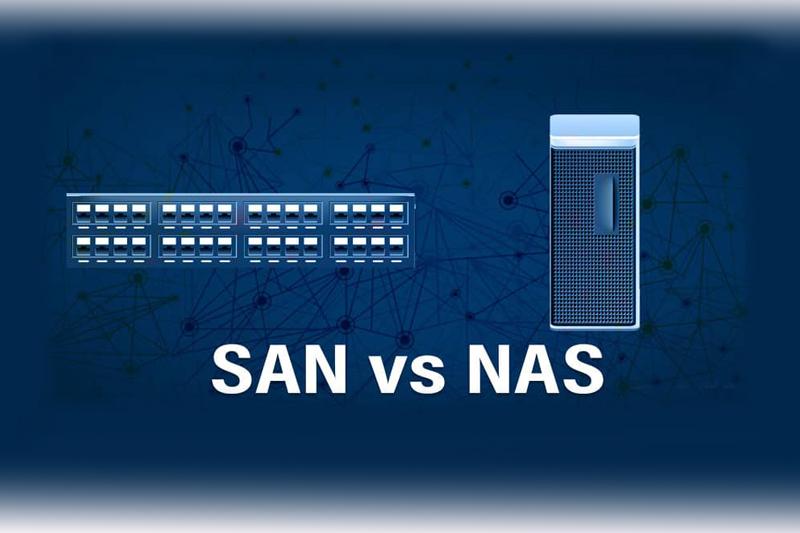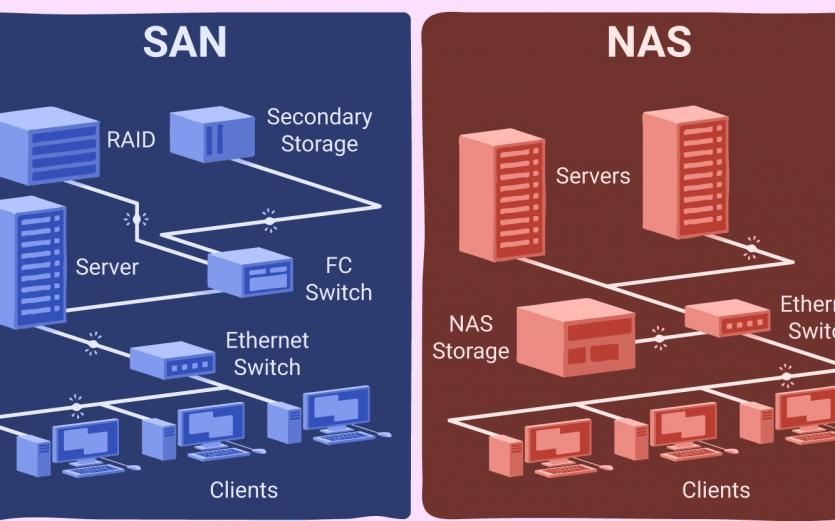Storage Network vs Network Storage: What’s the Real Difference?
“Storage Network” And “Network Storage”: You Have Several Options When It Comes To Backing Up Your Data Or Having To Back Up Your Data. For Example, You Can Use An External Hard Drive.
However, this approach is helpful for archiving information that is not very bulky in the short term. A better option is to buy storage under a network (NAS) header.
Network-attached storage is a comprehensive mechanism for archiving and sharing folders between users and other features. However, this approach is not very responsive in large organizations like financial institutions.
What is a storage space network (SAN)? Large organizations need a more comprehensive Storage Area Network (SAN) solution. Each of these technologies has its advantages, disadvantages, and applications. If you want to know what network storage is, what network storage is, and the differences between the two technologies, read on.
Let’s start with the storage space network. A storage space network is a high-performance and fast network of servers, devices, and storage equipment that provides access to integrated storage space at the block level. Different devices can connect to and interact with this network in a SAN-based environment.
The SAN storage network can be implemented independently of the local network to improve network performance, data protection mechanisms, and post-crisis recovery if needed.
What are the components of a SAN storage network?
As mentioned, storage space networks are physically implemented independently of the local network, so it is possible to implement them on different sites. Typically, storage space networks consist of age switches, hosts, and storage devices connected to the LAN based on proprietary protocols and hardware interfaces.
What are the benefits of SANs?
In general, organizations use the storage space network to increase productivity, as it provides an integrated storage and sharing mechanism and, in addition, enables the implementation of security solutions to protect the data available to network administrators. The essential advantages of SAN are the following:
- Extensibility: The SAN network can be adapted to the evolving needs of the business. For example, if you have more storage space, you can increase storage capacity. Therefore, expanding this space is no problem.
- Backup: Data backup is the biggest concern of organizations and network experts. If you use a SAN, you will have access to a comprehensive solution for backing up data on the organization’s various local area networks.
- Reduce LAN Bandwidth Problems: Because a large portion of network traffic is used to transmit packets, LAN-based storage systems face the problem of significant bandwidth bottlenecks. In addition, access to multimedia files on equipment may be delayed due to a lack of bandwidth. However, when you implement a SAN network, it has its own traffic. Thus, the overall performance of the local network is maintained, and the access time to the files is shorter.
- Data security: Using the SAN network, network administrators can use different security mechanisms based on the sensitivity of the information, and will have more options. In addition, because the data is on a separate network, if the hackers succeed in infiltrating the local network, the data will not be compromised because they are on another independent network.
- Post-crisis recovery: An organization’s employees can easily back up data to another device. If there is a problem with the information stored on the client equipment or servers, the information has been deleted or distorted by a hacker attack, and the recovery will be made in the shortest time.
Disadvantages of SAN
While SANs have many advantages for organizations, they have their disadvantages. The most important disadvantages of these networks are the following:
- Complexity: A SAN network has a relatively complex implementation, making it difficult to maintain and manage. Experts with accurate information about the various aspects of these networks are needed.
- Cost: Because SAN networks are made of different components, the cost of purchasing, maintaining, and implementing them is high. Therefore, they may not be a good option for small—to medium-sized companies.
- Management: Monitoring SAN networks is challenging. Therefore, network experts are needed to manage them.
The most common SAN protocols
Today, the following three protocols are used when implementing SAN networks.
- Fiber Channel Protocol: This high-speed data transfer protocol transmits data at the block level with a minor loss (Lossless). A fiber channel connects storage equipment to servers in the SAN network in data centers. This protocol in the SAN network functions similarly to the TCP / IP protocol in shared networks.
- Internet Small Computer System Interface: The iSCSI protocol consists of SCSI commands within an Ethernet framework, using an IP-based Ethernet network to transmit data.
- Fiber Channel over Ethernet: The Ethernet Fiber Channel (FCoE) protocol works like iSCSI because it inserts an FC frame into the Ethernet datagram. This protocol also transmits data over the IP Ethernet network.
How does SAN work?
SAN provides a high-speed infrastructure for servers to connect to logical disk drives. A logical disk drive is an array of blocks based on a set of storage units represented as a logical disk on the server.
Hence, when you connect to a SAN from a local network or a server, the network is displayed as a local disk. It is done so that each client device can store the data in a logical unit, just as it stores information on any local machine.
In other words, abstracting the technical details provides the user with a simple, usable solution. Accurately implemented SAN networks offer minimal data loss rates and the highest fault tolerance threshold.
Examples of real-time SAN applications
SANs have a local file system that enables servers to partition and format blocks as local storage units. SANs can be used as a backup mechanism for Performance-Sensitive applications. These applications include the following:
- Oracle Databases: Oracle databases are used for business-sensitive operations because they provide the highest rates of performance and accessibility.
- Microsoft SQL Server: Microsoft SQL Server databases store valuable organizational information and provide the highest performance and accessibility, as in the example above. However, Oracle databases are the first choice on a large scale and organizationally.
- Virtualization Deployments Using Microsoft Hyper-V, WiMAV, and KVM: These environments host thousands of virtual machines that run various operating systems and applications, and are scalable. Because virtual machines support multiple applications, infrastructure reliability is important because a simple failure can cause applications to malfunction.
- Virtual Desktop Infrastructures (VDIs): Organizations use virtual desktop environments to reduce costs. Organizations can improve data security and simplify management by centralizing user access to a single location. In this way, users connect to the central server through not-so-expensive equipment.
- SAP, large ERP, or CRM environments: SAN architectures can be the best choice for accurate resource management, allowing users and applications to access resources based on a precise schedule.
It should be noted that hard disks are being replaced or integrated with solid-state memory, so today’s SAN storage environments combine solid-state memory and hard disks to achieve both high speed and storage space standards.
What is a network storage device?
Network-Attached Storage (NAS) Network-Attached Storage, as its name implies, is a network-based storage solution. NAS-based storage provides a central storage management method for sharing storage space across multiple servers.
NAS uses an Ethernet-based communication mechanism instead of the SAN network, which uses Ethernet and FC. In addition, NAS focuses on ease of use, lower ownership costs, and ease of management.
Another critical difference between the two is the partitioning of storage space by NAS controllers. While data storage in the SAN is block-level, NAS accesses data based on the file system. It can use the NAS server like any other file server based on the client-server architecture.
Advantages of NAS
Like the network storage space, the network-based storage mechanism has its advantages. The advantages of NAS include the following:
- Architecture: NAS data is located in files and folders instead of blocks.
- Security: NAS provides good protection by controlling user access and additional data structures.
- Productivity: NAS delivers an easy, fast, inexpensive way to store data.
- Cost: Purchasing and maintaining a NAS is cost-effective. Sometimes, it may cost more to buy a high-end NAS than a regular SAN; however, it is more cost-effective than a SAN.
- Stability: Network storage provides better stability by eliminating individual servers used as a single point of failure, provided it is appropriately configured based on RAID.
Disadvantages of NAS
While networked storage has its advantages, it also has its disadvantages. Among these disadvantages are the following:
- Single Point of Failure: A single point of failure refers to a state where the performance of different parts will stop if other components fail. Because the NAS is implemented as a local backup drive on the network, it may cause data loss if it encounters a problem unless the proper read architecture is used.
- Speed problem: Excessive access to NAS increases network traffic and decreases performance.
- Scalability: Scalability is not readily available on NAS devices due to hardware limitations.
- Storage space quota: System administrators should apply a storage space quota to users to prevent excessive use of userspace by a particular client.
- Management: To implement NAS, you must have a basic knowledge of networking and hardware requirements, such as hard disks and solid-state memory.
- Performance: A NAS device’s capabilities depend on its design type and hardware components. NASs are typically used for storage purposes only.
The table below shows the essential differences between the two technologies, SAN and NAS.
The most common NAS protocols
Typically, NAS equipment is used based on the following two protocols:
- Common Internet File Services / Server Message Block: A protocol used by the Windows operating system.
- Network File System: A protocol first developed for Unix servers and used today in Linux operating systems.
How to choose between NAS and SAN?
Small—to medium-sized businesses typically use NAS, but larger organizations use SANs to manage large volumes of data. Before investing in a storage system, evaluate the following to choose one that suits the organization’s needs.
- Review of architectural requirements.
- Data processing models.
- Network protocols and capabilities.
- Functional limitations.
- Scalability requirements.
- Assets to be managed.
- Backup Challenges.
- Redundancy requirements.
- Post-crisis recovery.
- Virtualization options.
- Price.
Flexible storage selector
Whether you are storing databases or other types of data, SAN’s flexible storage space is not comparable to NAS. SAN is cost-effective in the long run, offers good remote management and control capabilities, and offers better security against cyber attacks; Therefore, it provides good capabilities to organizations with teleworkers. However, SAN is more suitable for large organizations or companies.
FAQ
What is SAN vs NAS?
SAN provides block-level storage over a specialized network, ideal for high performance. NAS offers file-level access over Ethernet and is simpler and more affordable.
Which is better for small businesses?
NAS is usually sufficient for small to medium-sized businesses due to lower cost and easier setup.
When should a large organization use SAN?
When they need high speed, reliability, low latency, and scalability for mission-critical applications or large-scale data handling.

